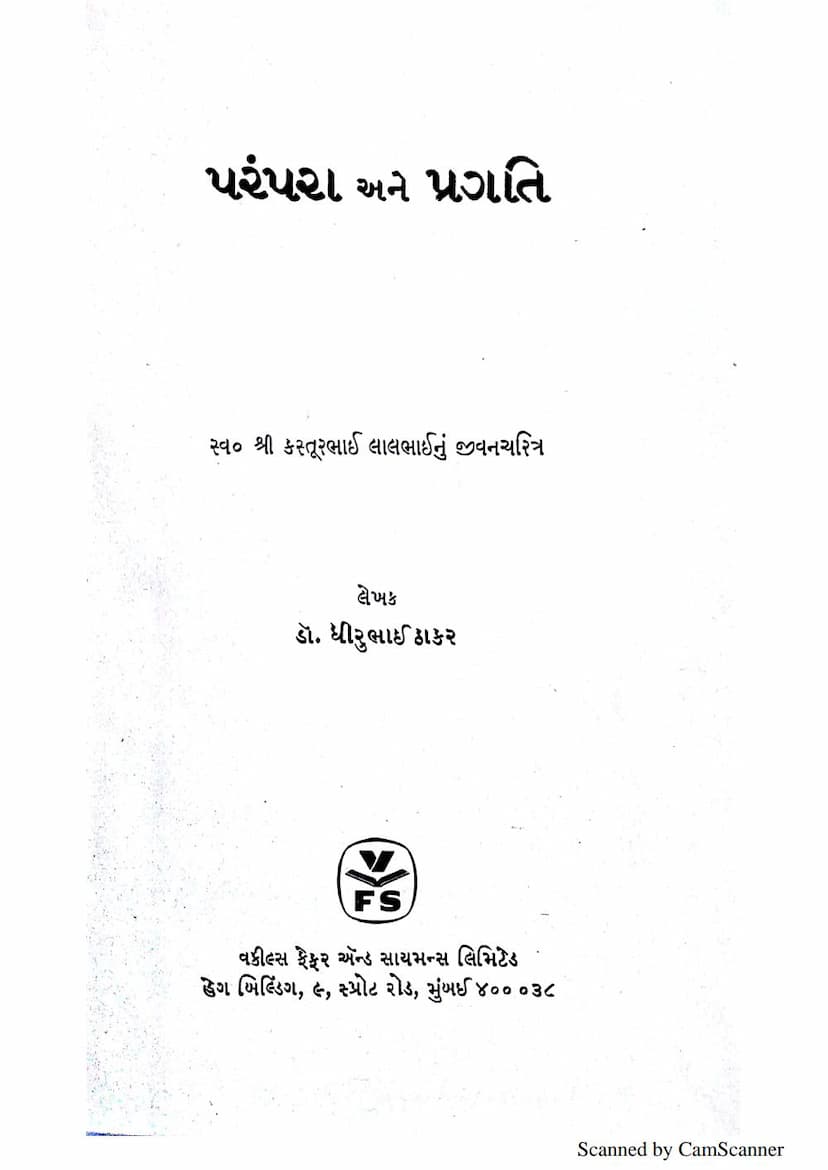Parampara Ane Pragati
Added to library: September 2, 2025

Summary
Parampara Ane Pragati: A Comprehensive Summary in English
"Parampara Ane Pragati" (Tradition and Progress), authored by Dr. Dhirubhai Thakar, is a biographical account of the life and achievements of the eminent industrialist Kasturbhai Lalbhai. Published by Vakil Fafer and Simons Limited, the book delves into the principles and practices that guided Kasturbhai's journey from a traditional business background to becoming a pioneering industrialist, deeply involved in the socio-economic and cultural development of Gujarat and India.
The book is structured to explore Kasturbhai's life through various phases and aspects, beginning with the historical context of Ahmedabad and its unique mercantile traditions. It then traces his family lineage and the values inherited from generations of astute businessmen and philanthropists, emphasizing the "parampara" (tradition) that shaped his early life and worldview.
Key themes and aspects covered in the book include:
-
Ahmedabad's Unique Identity: The initial chapters highlight Ahmedabad's distinct character as a city that thrived on its indigenous traditions and the enterprise of its people, successfully navigating economic challenges and foreign competition. The text emphasizes the inherent qualities of Gujaratis, particularly the Amdavadis, such as their diligence, thrift, patience, and shrewd business acumen.
-
The Mahajan Tradition: The book extensively discusses the traditional "Mahajan" system, a guild-like organization of merchants and artisans that played a crucial role in Ahmedabad's economic and social life for centuries. It explains how these institutions protected trade, resolved disputes, and contributed to social harmony and the preservation of crafts, even wielding significant influence over rulers. Kasturbhai's deep understanding and engagement with this tradition are highlighted.
-
The Lalbhai Family Legacy: The text traces the heritage of the Lalbhai family, starting from Seth Shanti Das, who held significant influence during the Mughal era. It details the transition of the family's business from traditional jewelry and money-lending to embracing the burgeoning textile industry, a pivotal shift that marked a new direction for the family's enterprises and, by extension, Ahmedabad's industrial landscape. Kasturbhai's father, Lalbhai, is credited with laying the foundation for this industrial expansion.
-
Kasturbhai's Entry into Industry: The book details Kasturbhai's entry into the textile industry, initially facing challenges but eventually leading his family's mills to significant success. It highlights his strategic decisions, his focus on quality, and his innovative approach to business management, particularly the establishment of Arvind Mills.
-
Philanthropy and Social Responsibility: A significant portion of the book is dedicated to Kasturbhai's extensive philanthropic activities. It covers his contributions to educational institutions, including his role in the establishment of the Ahmedabad Education Society, Gujarat University, and premier research institutions like ATIRA and IIM Ahmedabad. His commitment to preserving Jain heritage through the meticulous restoration of ancient temples like Ranakpur and Delvada is also prominently featured.
-
National Contribution and Public Life: The book sheds light on Kasturbhai's involvement in national affairs, including his role in the Legislative Assembly, his participation in trade negotiations with foreign countries, and his efforts to advocate for policies beneficial to India's industrial growth, such as the abolition of excise duty on textiles. His association with prominent national leaders like Mahatma Gandhi, Sardar Vallabhbhai Patel, and Pandit Jawaharlal Nehru is also discussed, underscoring his commitment to nation-building.
-
Labor Relations and Welfare: The text touches upon Kasturbhai's approach to labor relations, highlighting his belief in fostering a harmonious relationship between management and labor. His efforts to improve workers' welfare and his understanding of their aspirations are presented as key elements of his management philosophy. The book acknowledges the challenges faced, such as strikes, but also emphasizes Kasturbhai's attempts at reconciliation and fair dealings.
-
Personal Life and Values: Interspersed with his professional and public life, the book offers glimpses into Kasturbhai's personal life, his values, his relationship with his family, and his adherence to Jain principles of moderation and non-violence. His meticulous approach to personal finance, his refined taste, and his deep respect for his elders are highlighted.
-
The "Utamna Abhilashi" (Aspiring for the Best) Philosophy: A recurring theme is Kasturbhai's relentless pursuit of excellence, his aspiration for the best in all his endeavors, whether in business, philanthropy, or personal conduct. This drive for quality and his commitment to ethical practices are presented as the bedrock of his success.
In essence, "Parampara Ane Pragati" presents Kasturbhai Lalbhai as a multifaceted personality who masterfully blended tradition with progress. He exemplified a visionary industrialist, a dedicated philanthropist, and a conscientious citizen who significantly contributed to India's journey towards self-reliance and modernization. The book serves as a tribute to his enduring legacy and an inspiration for future generations of entrepreneurs and nation-builders.